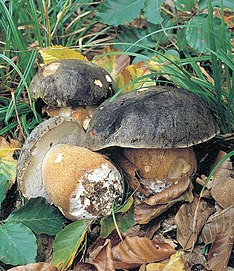Boletus aereus
| Boletus aereus | |
|---|---|
 |
|
| Scientific classification | |
| Kingdom: | Fungi |
| Division: | Basidiomycota |
| Class: | Agaricomycetes |
| Order: | Boletales |
| Family: | Boletaceae |
| Genus: | Boletus |
| Species: | B. aereus |
| Binomial name | |
|
Boletus aereus Bull. (1789) |
|
| Synonyms | |
| Boletus aereus | |
|---|---|
| Mycological characteristics | |
| pores on hymenium | |
| cap is convex | |
| hymenium is adnate | |
| stipe is bare | |
| spore print is olive-brown | |
| ecology is mycorrhizal | |
| edibility: choice | |
Boletus aereus, the dark cep or bronze bolete, is a highly prized and much sought-after edible mushroom in the family Boletaceae. The bolete is widely consumed in Spain (Basque Country and Navarre), France, Italy, Greece, and generally throughout the Mediterranean. Described as a new species in 1789 by French mycologist Pierre Bulliard, it is closely related to several other European boletes, including B. reticulatus, B. pinophilus, and the popular B. edulis. Some populations in North Africa have been classified as a separate species, B. mamorensis, although they are phylogenetically very close.
The fungus predominantly grows in habitats with broad-leaved trees and shrubs, forming symbiotic ectomycorrhizal associations in which the underground roots of these plants are enveloped with sheaths of fungal tissue (hyphae). The cork oak (Quercus suber) is a key host. The fungus produces spore-bearing fruit bodies above ground in summer and autumn. The fruit body has a large dark brown cap, which can reach 30 cm (12 in) in diameter. Like other boletes, B. aereus has tubes extending downward from the underside of the cap, rather than gills; spores escape at maturity through the tube openings, or pores. The pore surface of the fruit body is whitish when young, but ages to a greenish-yellow. The squat brown stipe, or stem, is up to 15 cm (6 in) tall and 10 cm (4 in) thick and partially covered with a raised network pattern, or .
...
Wikipedia
